Chemical Water Purification Methods
Water purification is a critical process for ensuring that water is safe for human consumption and environmental protection. Among the various methods available, chemical purification techniques are widely employed due to their effectiveness in eliminating contaminants. This article explores some of the most common chemical water purification methods.
One of the primary chemical methods used in water purification is chlorination. Chlorine, a powerful disinfectant, is added to water to kill bacteria, viruses, and other pathogens. This technique is widely used in municipal water treatment plants and has significantly reduced waterborne diseases. While effective, chlorination can lead to the formation of harmful by-products, such as trihalomethanes (THMs), which raises concerns about long-term health effects. Therefore, careful monitoring and control of chlorine levels are essential.
Another chemical purification method is the use of ozone treatment. Ozone (O3) is a strong oxidizing agent that can effectively destroy organic and inorganic contaminants. It is particularly beneficial for removing taste, odor, and color from water. Ozone treatment is also safer than chlorine since it decomposes quickly into oxygen and leaves no harmful residues. However, ozone systems require specialized equipment and can be more expensive to operate.
chemical water purification methods

Coagulation and flocculation are critical steps in chemical purification that involve the addition of coagulants, such as aluminum sulfate, to water. These chemicals bind with suspended particles, forming larger aggregates known as flocs. The flocs can then be easily removed through sedimentation and filtration. This method is particularly useful in treating water with high turbidity and helps in the clarification of drinking water.
Additionally, the use of activated carbon in water treatment is a common practice for removing organic compounds, chlorine, and other contaminants. Activated carbon adsorbs impurities, improving the water's taste and odor. This method is often used in conjunction with other purification techniques to enhance overall water quality.
Lastly, chemical precipitation is employed to remove specific dissolved substances, such as heavy metals or phosphates, from water. By adding certain chemicals, contaminants can be transformed into solid particles that can then be filtered out.
In conclusion, chemical water purification methods are essential for providing safe drinking water and protecting public health. While chlorination, ozone treatment, coagulation, activated carbon, and precipitation are among the most common strategies employed, ongoing research and innovation in water treatment technologies continue to improve the efficacy and safety of these methods. As water quality issues become increasingly pressing, the role of chemical purification in achieving clean water for all is more important than ever.

